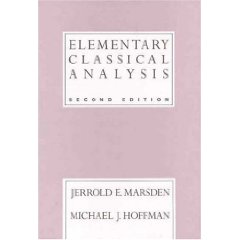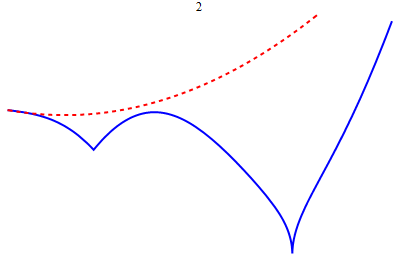CRN 16078
From Classes
(Difference between revisions)
HelmutKnaust (Talk | contribs) (Created page with "===Syllabus=== * right '''Time and Place.''' TR 17:00-18:20, LART 308 * '''Instructor.''' Helmut Knaust, Bell Hall 219, hknaust@utep.edu, 747-7002 * '''O...") |
Revision as of 15:31, 26 August 2018
Contents |
Syllabus
- Time and Place. TR 17:00-18:20, LART 308
- Instructor. Helmut Knaust, Bell Hall 219, hknaust@utep.edu, 747-7002
- Office Hours. TR 15:00-16:20, or by appointment.
- Textbook. Jerrold E. Marsden & Michael J. Hoffman, Elementary Classical Analysis, 2nd ed., W.H. Freeman and Co., New York.
- Prerequisites. MATH 3341 (Introduction to Analysis), or equivalent. The prerequisite material can be found for instance in: Edward D. Gaughan, Introduction to Analysis, 5th ed., Ch. 0-5.
- Course Content. We will study the concept of a metric space. The rational numbers are dense in the set of real numbers: for every real number we can find a rational number arbitrarily close. If we want to consider the related question, whether and in what sense polynomials are dense in the set of continuous functions, we are naturally led to the general concept of the distance between two mathematical objects. A set with a distance function is called a metric space. In the first part of the course, you will learn about basic properties metric spaces might have, such as compactness, completeness and connectedness. As one of the most important examples of metric spaces we will then study the space of continuous functions with its notion of uniform convergence. One of the highlights of the course will be the proof of the Stone-Weierstrass-Theorem, which generalizes the result about polynomials mentioned above.
- In-class Presentations. Mathematics is not a spectator sport. While I will lecture for a good portion of class time, I will regularly call on students to give presentations of results in the textbook they have prepared at home. Your chances of passing the course without spending a significant amount of time on preparing in-class presentations are limited: Your in-class work will account for 20% of your grade.
- Homework. You will be regularly assigned written homework problems, which will be graded. Graduate students will be required to work on some extra problems. Your homework grade will contribute 25% towards your grade.
- Tests. The midterm will take place on Tuesday, October 13. The final on Tuesday, December 8, 16:00-18:45, is mandatory and comprehensive. The exams will count 25% and 30%, respectively.
- Time Requirement. I expect that you spend an absolute minimum of six hours a week outside of class on reading the textbook, preparing for the next class, reviewing your class notes, and completing homework assignments. Not surprisingly, it has been my experience that there is a strong correlation between class grade and study time.
- Attendance. You are strongly encouraged to attend class. Students with five absences (excused or unexcused) will be dropped from the course with a grade of "F".
- Drop Policy. The class schedule lists Friday, October 30, as the last day to drop with an automatic "W". After the deadline, I can only drop you from the course with a grade of "F".
- Students with Disabilities. If you have a disability and need special accommodation, please contact the Disabled Student Services Office (DSSO) in Union East 106, 747-5148, dss@utep.edu.
- Academic Integrity. All students must abide by UTEP's academic integrity policies, see http://academics.utep.edu/Default.aspx?tabid=23785 for details.
Homework
- 11/17/09: Read 5.6,5.7
- 11/10/09: Read 5.1-5.4. Prepare pp.255-259.
- 10/27/09: Read 4.4-4.7.
- 10/22/09: Read 4.3-4.5. Prepare 4.3.2iii+
- 10/20/09: Read 4.2-4.4. Prepare 4.2-4.3.
- 10/15/09: Read 4.2-4.4. Prepare 4.2-4.3.
- 10/13/09: Midterm exam
- 10/12/09: Extra office hours 10:00-12:00, 14:00-17:00
- 10/8/09: Read 4.1-4.3. Prepare 4.2-4.3.
- 10/6/09: Read 4.1-4.3. Prepare 4.2-4.3.
- 10/1/09: Read 4.1-4.3. Prepare 4.2-4.3.
- 9/29/09: Read 3.4-3.5.
- 9/24/09: Read 3.3-3.4.
- 9/22/09: Read 3.1-3.2.
- 9/17/09: Read 3.1-3.2.
- 9/15/09: Prepare 2.9 (\(\geq\)2.9.4.iv)
- 9/10/09: Prepare 2.9.
- 9/8/09: Read 2.7-2.9. Prepare 2.9.
- 9/3/09: Read 2.6-2.9. Prepare 2.6.
- 9/1/09: Read 2.5-2.9. Prepare 2.5 and 2.6.
- 8/27/09: Read 2.1-2.6. Prepare 2.5 and 2.6.
- 8/25/09: Read 1.5-1.7, 2.1-2.2.
Written Homework
- Homework 7 | Homework 6 | Homework 5 | Homework 4 | Homework 3 | Homework 2 | Homework 1

